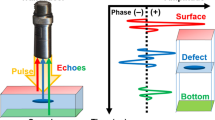Abstract
In recent years, acoustic microscopy has been found to be very useful for characterizing engineering as well as biologic materials. With the present state of knowledge on acoustic microscopy, one can obtain the surface wave velocity of a homogeneous specimen or coating thickness of a coated material and produce images of near surface internal defects and inhomogeneities in a specimen. Applications of acoustic microscopy for obtaining material properties of anisotropic specimens and detecting material defects at a greater depth are meager because commercially available acoustic microscopes are insensitive to direction-dependent material properties and they, in general, have poor penetration properties because of high operating frequencies. Recently at the University of Arizona an unconventional low frequency (0.5–2.5 MHz) acoustic microscope has been fabricated where the microscope lens has been replaced by two ultrasonic transducers with cylindrical concave faces; one works as a transmitter and the other one works as a receiver. Using this arrangement, it has been found that it is possible to detect internal damages in a material and identify material anisotropy in fiber-reinforced composite plates. These capabilities of the microscope are demonstrated in this paper by presenting some experimental results along with theoretical justifications. Then pattern recognition techniques are used to solve the inverse problem, that is, to predict the type of material defect from reflected acoustic signals.
Similar content being viewed by others
References
J. Kushibiki, A. Ohkubo, and N. Chubachi. 1982. Effect of leaky SAW parameters onV(z) curves obtained by acoustic microscopy,Electron. Lett. 18:668.
J. Kushibiki, Y. Matsumoto, and H. Chubachi. 1983. Material characterization by acoustic microscope with line-focus beam, inAcoustical Imaging, Vol. 13 (Plenum Press, New York), p. 193.
J. Kushibiki, A. Ohkubo, and N. Chubachi. 1982. Material characterization by acoustic line-focus beam, inAcoustic Imaging, Vol. 12 (Plenum Press, New York). p. 101.
R.D. Weglein. 1980. Acoustic microscopy applied to SAW dispersion and film thickness measurement.IEEE Trans. Son. Ultrason. SU-27:82.
R.D. Weglein. 1982. Non-destructive film thickness measurement on industrial diamond.Elect. Lett. 18:1003.
M.G. Somekh, G.A.D. Briggs, and C. Ilett. 1983. Detection of surface-breaking cracks in the acoustic microscope, inAcoustical Imaging, Vol. 13 (Plenum Press, New York). p. 119.
J.M.R. Weaver, M.B. Somekh, G.A.D. Briggs, S.D. Peck, and C. Ilett. 1985. Application of the scanning reflection acoustic microscope to the study of Materials Science.IEEE Trans. Son. Ultrason. SU-32:302.
K. Yamanaka, Y. Enomoto, and Y. Tsuya. 1985. Acoustic microscopy of ceramic surfaces.IEEE Trans. Son. Ultrason. SU-32:313.
A.J. Miller. 1985. Scanning acoustic microscopy in electronics research.IEEE Trans. Son. Ultrason. SU-32:320.
K. Yamanaka, Y. Enomoto, and Y. Tsuya. 1982. Application of scanning acoustic microscope to the study of fracture and wear.Acoustic Imaging, Vol. 12 (Plenum Press, New York). p. 79.
K. Liang, B.T. Khuri-yakub, S.D. Bennett, and G.S. Kino. 1983. Phase measurements in acoustic microscopy, Proc. Ultrasonics Symposium, Vol. 2, Atlanta, Georgia. p. 591.
J.A. Hildebrand and D. Rugar. 1984. Measurement of cellular elastic properties by acoustic microscopy.J. Micros. 134:245.
J. Litniewski and J. Bereiter-Hahn. 1990. Measurements of cells in culture by scanning acoustic microscopy.J. Micros. 158:95.
T. Kundu, J. Bereiter-Hahn, and K. Hillmann. 1991. Measuring elastic properties of cells by evaluation of scanning acoustic microscopyV(z) values using simplex algorithm.Biophys. J. 59:1194.
A. Atalar. 1978. An angular spectrum approach to contrast in reflection acoustic microscopy.J. Appl. Phys. 49:5130.
R.D. Weglein. 1979. A model for predicting acoustic material signature.Appl. Phys. Lett. 34:179.
C.F. Quate. 1980. Microwaves, acoustics and scanning microscopy, inScanned Imaging and Microscopy. E.A. Ash, ed. (Academic Press, London), p. 23.
T. Kundu, A.K. Mal, and R.D. Weglein. 1985. Calculation of the acoustic material signature of a layered solid.J. Acoust. Soc. Am. 77:353.
T. Kundu and A.K. Mal. 1986. Acoustic material signature of a layered plate.Int. J. Engr. Sci. 24:1819.
T. Kundu. 1988. Acoustic microscopy at low frequency.ASME J. Appl. Mech. 55:545.
T. Kundu. 1988. A theoretical analysis of acoustic microscopy with converging acoustic beams.Appl. Phys. B. 46:325.
J. Kushibiki and N. Chubachi. 1985. Material characterization by in line-focus-beam acoustic microscope.IEEE Trans. Son. Ultrason. SU-32:189.
T. Kundu. 1988. On the nonspecular reflection of bounded acoustic beams.J. Acous. Soc. Am. 83:18.
M.A. Awal, T. Kundu, and S.P. Joshi. 1989. Dynamic behavior or delamination and transverse cracks in fiber reinforced laminated composites.Eng. Fract. Mech. 33:753.
S.P. Joshi and C.T. Sun. 1985. Impact induced fracture in a laminated composite.J. Comp. Mater. 19:51.
A.K. Mal and S.J. Singh. 1991.Deformation of Elastic Solids (Prentice Hall, New Jersey). 290.
V.K. Kinra and V. Dayal. 1988. New technique for ultrasonic-nondestructive evaluation of thin specimens.Exp. Mech. 28(3):288.
D. Casasent. 1984. Unified synthetic discriminant function computational formulation.Appl. Op. 23:1620.
D. Casasent and W.T. Chang. 1986. Correlation synthetic discriminant functions.Appl. Op. 25:2343.
R.R. Kallman. 1986. Construction of low noise optical correlation filters.Appl. Op. 25:1032.
B.V.K. Vijaya Kumar. 1986. Minimum variance synthetic discriminant functions.J. Op. Soc. Am. A3:1579.
A. Mahalanobis, B.V.K. Vijaya Kumar, and D. Casasent. 1987. Minimum average correlation energy filters. Appl. Op.26:3633.
Author information
Authors and Affiliations
Rights and permissions
About this article
Cite this article
Awal, M.A., Mahalanobis, A. & Kundu, T. Low frequency acoustic microscopy and pattern recognition for studying damaged and anisotropic composites and material defects. J Nondestruct Eval 11, 19–28 (1992). https://doi.org/10.1007/BF00566014
Received:
Revised:
Issue Date:
DOI: https://doi.org/10.1007/BF00566014




